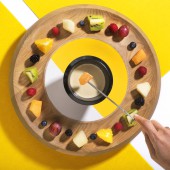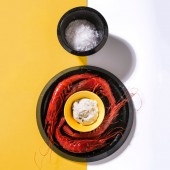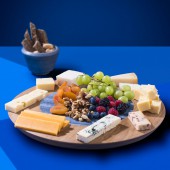
| THE AWARD |
| CATEGORIES |
| REGISTRATION |
| SUBMIT YOUR WORK |
| ENTRY INSTRUCTIONS |
| TERMS & CONDITIONS |
| PUBLICATIONS |
| DATES & FEES |
| METHODOLOGY |
| CONTACT |
| WINNERS |
| PRESS ROOM |
| GET INVOLVED |
| DESIGN PRIZE |
| DESIGN STORE |
| THE AWARD | JURY | CATEGORIES | REGISTRATION | PRESS | WINNERS | PUBLICATIONS | ENTRY INSTRUCTIONS |
Agape Multifunctional Tableware by id.real |
Home > Winners > Design #64944 >Interview |
 |
|
FS: What is the main principle, idea and inspiration behind your design?
ID: Today’s habits around the table have changed. However, the classic tools continue to persist in the market without adaptations to the user needs. Agape is the perfect answer to these evolutions of habits and a way to re-discover the art of sharing.
FS: What has been your main focus in designing this work? Especially what did you want to achieve?
ID: The main objective of the project is to enhance the experience of eating and sharing around the table by creating functional and flexible elements based on tradition and the partaking of meals together. It is thought to suit the modern lifestyle.
FS: What are your future plans for this award winning design?
ID: Agape is currently under production and the launch is scheduled by the end of 2018. At the same time, we are looking for a partnership with a brand or brands working in the food/Design industry to have a joint adventure.
FS: How long did it take you to design this particular concept?
ID: The concept and development phases lasted 5 months in total.
FS: Why did you design this particular concept? Was this design commissioned or did you decide to pursuit an inspiration?
ID: In id.real we put the end user at the core of our designs. After we researched the market, we decided to pursue our inspiration. We had noticed a clear trend in Food Design and elements for the table; an increase in the consumption of ceramic material, and a willingness to innovate in a very competitive field but always focused on aesthetics rather than functionality. Agape, however, is the perfect balance between both characteristics and the essence of Design.
FS: Is your design being produced or used by another company, or do you plan to sell or lease the production rights or do you intent to produce your work yourself?
ID: Our idea is to have a partnership with a brand, signing an agreement where both parts (id.real and the other company) can successfully generate revenues from the project. That way, we can start working on other complementary projects that may enhance even more the art of sharing.
FS: What made you design this particular type of work?
ID: The everyday objects not only fulfill a function, it is necessary to incorporate other features so that the interaction with users will be easier and more efficient, more gratifying. The value is to allow the consumer to experience with the objects and find new ways to use them. That is the essence of design: by integrating people into the process you will obtain unexpected results.
FS: Where there any other designs and/or designers that helped the influence the design of your work?
ID: No -our inspiration comes from the users’ needs and experiences.
FS: Who is the target customer for his design?
ID: Agape’s motto explains it pretty well: Dare to share! The target customers are people between 25 and 40 years old, with sensitivity for art and design. Our typical user is an outgoing person, a travel lover and, above all, enjoys good company while eating. Agape becomes an element to foster interaction between diners.
FS: What sets this design apart from other similar or resembling concepts?
ID: the concept not only surprises with its design, but it really facilitates the way of serving meals. Agape brings an element of surprise, ergonomics, interaction and, above all, it is a design born from the changes detected in the current society, the answer to the cultural mix of food, adapt itself to the new the ways of eating (alone or accompanied), the user's gestures, the multifunction. It is all about people, not objects.
FS: How did you come up with the name for this design? What does it mean?
ID: The word agape derives from the Latin "agăpe" and from the Greek "ἀγάπη" which can be translated as “warmth" or "love". The word Agape is used to allude to fraternal food to strengthen the bonds that unite people. This is why agape is known as a banquet, or a meal held to celebrate a thing, be it a private or public meeting, which can also be collective or held outdoors, which is done with the intention of celebrating some event or to delight a guest. Also in Spanish means banquet.
FS: Which design tools did you use when you were working on this project?
ID: We work following the Design Thinking philosophy what means using tools as co-design sessions, user testing sessions, interviews with experts and users, prototyping-testing-improving process. As well common design tools: physical prototypes, digital prototypes, renders.
FS: What is the most unique aspect of your design?
ID: Versatility, originality, simplicity. The design was studied to meet the needs of today’s uses and surprise diners.
FS: Who did you collaborate with for this design? Did you work with people with technical / specialized skills?
ID: We worked with end users to respond to their needs. We contacted manufacturers to test the product through prototypes.
FS: What is the role of technology in this particular design?
ID: There is no technology in this design, though we are working on adding it in the following phases. After all, we are in the great pursuit of the integration of physical and digital: phygital.
FS: Is your design influenced by data or analytical research in any way? What kind of research did you conduct for making this design?
ID: We did a wide research at the beginning of the project about user habits; how they eat and share food during the meal; how user interact during the spare time; what are their aspirations; what they cook, eat, buy and how they connect with their emotions through everyday objects. The research included also materials, production process and trends.
FS: What are some of the challenges you faced during the design/realization of your concept?
ID: Finding the right balance between functionality and aesthetics; creating objects that adapt to the various domestic uses of today and serve different targets. The production of the prototypes has been complex due to the different materials that compose the set and very stylized decorations with saturated colors, which makes hard the artisanal production of the pieces.
FS: How did you decide to submit your design to an international design competition?
ID: We think that innovative design should be shared with the greater audience. One of the good things about design contests is that they give designers and studios the opportunity to present their proposals to the world and make people aware of the new trends in our society.
FS: What did you learn or how did you improve yourself during the designing of this work?
ID: Research and testing have helped us to find the answers we needed to design our product. In this way, we had a solid base from where to develop Agape. We improve processes and we left our subjective opinion aside in favor of a more objective vision.
FS: Any other things you would like to cover that have not been covered in these questions?
ID: id.real is willing to engage with users, fans, professionals and anyone interested in design… we are eager to create new adventures hand in hand with you. So, anytime you are in Madrid, don’t be shy, come and say ‘hi’, share a cup of Joe and let’s design the next best thing together!
FS: Thank you for providing us with this opportunity to interview you.
A' Design Award and Competitions grants rights to press members and bloggers to use parts of this interview. This interview is provided as it is; DesignPRWire and A' Design Award and Competitions cannot be held responsible for the answers given by participating designers.
| SOCIAL |
| + Add to Likes / Favorites | Send to My Email | Comment | View Press-Release |





